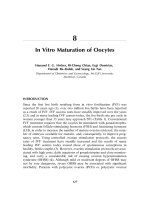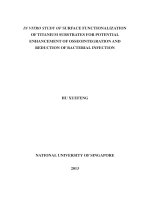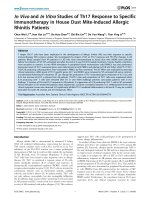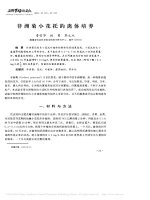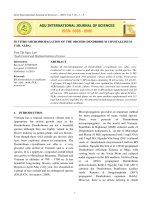In vitro regeneration of black pepper (piper nigrum l ) (24 pages)
Bạn đang xem bản rút gọn của tài liệu. Xem và tải ngay bản đầy đủ của tài liệu tại đây (8.74 MB, 24 trang )
In vitro REGENERATION OF BLACK PEPPER (Piper nigrum L.)
Anny Jong
Master of Science
2011
In vitro REGENERATION OF BLACK PEPPER (Piper nigrum L.)
P.KHIDMAT MAKLUMAT AKADEMIK
111I1111I11i'i]111
"IIII
1000246443
ANNYJONG
A thesis submitted
in fulfillment of the requirement for the Degree of
Master of Science
(Plant Tissue Culture)
Faculty of Resources Sciences and Technology
UNlVERSITI MALAYSIA SARA W AK
2011
DECLARATION
I hereby declare that no portion of the work referred to this thesis has been submitted in support
of an application for another degree or qualification to this or any other university or institution
of higher learning.
(
Anny Jong
Date: 01 51 July 2011
)
Pusat l(bidmat MaJdumat Ak demik
f.JNJVER1
rn
MALAY 1A SAnA\\~,,·
Table of Content
Acknowledgement
Abstract
I
II
Abbreviations
IV
List of Figures
V
List of Tables
1.0 Introduction
VOl
1
2.0 Literature Reviews
2. 1
2.2
2.3
2.4
2.5
2.6
Pepper vines
Micropropagation of Piper nigrum L.
Establishment of aseptic culture from field-derived explant
Endophytic bacteria in pepper plant
Browning problem in pepper in vitro culture
Multiple shoots formation
4
6
8
10
11
1
13
3.0 Materials and Methods
3.1 Establishment and maintenance of stock plants
3.2 Measures to control and eliminate microbial contaminants
3.2.1 Concentration of Clorox used in surface sterilization
3.2.2 Incorporation of antibiotics into the culture medium
3.2.3 Treatment of fungicide prior to surface sterilization
3.2.4 Root feeding of stock plants with antibiotic for the control of
endophytic bacteria
3.2.5 Stock plants raised in sterilized growing medium
3.3 Alleviating browning problem in pepper in vitro culture
3.4 Isolation and identification of microbial contaminants
3.5 Studies on different pathways of pepper micropropagation
3.5.1 Multiple shoots formation through proliferation of pre-existing
meristem
3.5.2 Shoot formation by organogenesis
3.5.3 Plantlets developed via somatic embryogenesis
16
16
16
17
17
18
20
21
21
22
22
24
24
I
3.6 Preliminary assessment on genetic stability of micro propagated plantlets
using RAPD
3.6.1 DNA extraction
3.6.2 Polymerase Chain Reaction (PCR) amplication
3.7 Acclimation of the in vitro plantlets
25
25
26
26
4.0 Results and Discussion
4.1 Establishment and maintenance of stock plants
4.2 Measures to control and eliminate microbial contaminants
4.2.1
4.2.2
4.2.3
4.2.4
Concentration of Clorox used in surface sterilization
Incorporation of antibiotics into the culture medium
Treatment of fungicide prior to surface sterilization
Root feeding of stock plants with antibiotic for the control of
endophytic bacteria
4.2.5 Stock plants raised in sterilized growing medium
4.3 Alleviating browning problem in pepper in vitro culture
4.4 Isolation and identification of microbial contaminants
4.5 Studies on different pathways of pepper micropropagation
4.5.1 Multiple shoots formation through proliferation of pre-existing
meristem
4.5 .2 Shoot formation by organogenesis
4.5.3 Plantlets developed via somatic embryogenesis
4.6 Preliminary assessment on genetic stability of in vitro plantlets using
RAPD
4.6.1 DNA extraction
4.6.2 Polymerase Chain Reaction (PCR) amplication
4.7 Acclimation of the in vitro plantlets
29
29
31
33
35
37
38
40
43
48
49
52
56
65
65
66
77
5.0 Conclusion and Recommendation
79
6.0 References
82
7.0 Appendix
89
,...
I
Acknowledgement
First of all, I wish to express my deepest gratitude and sincere appreciation to both
of my supervisors Assoc. Prof. Dr. Sim Soon Liang and Prof. Dr. Hamsawi Sani for their
advices, guidance and supports from the very beginning until the completion of this
research.
Secondly, I would like to acknowledge Mr. Paulus Amin and Hjh Rosmah, the
Senior Research Officers of Agriculture Research Centre (ARC) at Semongok, for
supporting this research by providing facilities and plant materials. Besides of that, I want
to record my appreciation to all the staff in Pepper Breeding Section at ARC Semongok
especially to Mr. Frank Sies and Mr. Peter for maintaining the plant materials in the
plant-house.
Last but not least, I want to devote my appreciation and utmost thankfulness to my
parents for their supports and thanks to my friends for their help during my implementation
of this research.
This research is financially supported b1 the Malaysian Pepper Board through grant
no. MPB-UNIMAS-ARC-Project 2-08 and the UNIM.AS ZAMALAH scholarship awards
to Anny Jong.
I
ABSTRACT
Black pepper (Piper nigrum L) or known as King of spices, is an important cash
crop of Malaysia and is widely used as food flavouring in the world. In vitro culture
technique was introduced in mass production of black pepper for a newly released variety
but, it is difficult to establish in vitro culture of black pepper due to the endophytic bacteria
in pepper plant. Consequently, several measures are suggested in obtaining axenic culture
of pepper.
0
begin with, the stock plants must be established from cutting planted in
sterilized soil mixture and maintained under hygienic condition inside a plant-house. The
explants were pre-soaking in 0.3% fungicide Benlate solution for one hour, following by
surface sterilized in 10% commercial bleach (Clorox®) for 10 minutes and culture in SH
medium supplemented with 0.3% PVP and antibiotic(s) tetracycline (l0 mglL) or penicillin
(100 mglL). For proliferation, shoot-tip explants with 5mrn in size were cultured in SH
medium supplemented with 2.5 mglL BAP and 0.5 mg/L kinetin. Mass production of
pepper plantlet via somatic embryogenesis has been very successful by cultured the seeds
in SH medium supplemented with 0.5 mg/L 2,4-D. As high as 84% successful rate of
acclimated piantlets were to be planted in the field to assess their field performance.
Key Words: Fungicide Benlate, commercial bleach, tetracycline, penicillin, PVP, 2,4-D,
BAP, kinetin.
II
I
Regenerasi In Vitro Lada Hitam (Piper nigrum L)
A BSTRAK
Lada hitam (Piper nigrum L.) atau dikenali sebagai Raja rempah merupakan
tanaman yang penting di Malaysia dan digunakan secara meluas sebagai penyedap
makanan. Teknik mikropropagasi diperlukan apabi/a variety baru dihasilkan. Namun,
sukar untuk membangun kultur in vitro bagi lada hitam disebabkan bakteria endojit pada
pokok lada. Dengan i!u, beberapa langkah disarankan untuk memperoleh kultur yang
aseptik. Tanaman induk harus di!anam dalam campuran tanah yang disterilkan dan
dibawah keadaan bersih di dalam rumah tanaman. Hujung pucuk perlu direndam dalam
larutan 0.3% fungisida Benlate selama satu jam, diikuti dengan 10% peluntur (ClOl"OX®)
selama 10 mini! dan dikultur dalam medium SH ditambah dengan 0.3% PVP and antibiotik
tetrasiklin (lO mg/L) atau penisilin (lOO mg/L). Untuk proliferasi, hujung pucuk dengan
ukuran 5mm dikultur dalam medium SH di!ambah dengan 2.5 mg/L BAP dan 0.5 mg/L
kinetin. Propagasi massa lada melalui embriogenesis somatik dilakukan dengan kultur
benih lada dalam medium SH ditambah dengan 0.5 mg/L 2,4-D. Sebanyak 84% plantlet
berjaya diaklimatisasikan dan ditanam di ladang untuk menilai prestasinya.
Kala Kunci: Fungisida Benlate, pemutih komersial, tetrasiklin, penisilin, PVp, 2,4-D, BAp,
kinetin.
III
,..
I
Abbreviations
2,4-D
2,4- Dichlorophenoxyacetic Acid
BA
N 6- Benzyladenine
BAP
6- Benyzlaminopurine
IAA
Indole':'3- Acetic Acid
KOH
Potasssium Hydroxide
NAA
Naphthalene Acetic Acid
PVP
Polyvinylpyrrolidone
TDZ
Thidiazuron
IV
List of Figures
Figure 1
The pepper vines planted in field.
Figure 2
Root feeding in pepper. (a) Feeding the underground roots. (b) Feeding
the aerial roots. (c) Feeding both the underground and aerial roots.
19
Figure 3
Studies
conducted
micro propagation.
pepper
23
Figure 4
Establishment of stock plants. (a-c) Transplanting a cutting into a clay
pot and filled with sterilized potting mix. (d) Removal of lateral
branches. (e) A young pepper plant with lateral branches removed.
(f) Anewly emerged shoot.
30
Figure 5
Establishment of stock p}ants
(a) Treating cut end of cutting
(b) Rooting cuttings in sand bin.
pots. (f) New shoots emerged from
m sterilized growmg medium.
with commercial rooting powder.
(c-e) Direct rooting of cuttings in
rooted cutting grown in pots.
39
Figure 6
(a) Browning of the shoot tip explant at five days of culture.
(b) Leaching of phenolic compounds caused medium around the
explant to tum brown.
41
Figure 7
Induction of multiple shoot formation. (a) Shoot explants cultured in
medium devoid PGR. (b) Shoot explants cultured in medium
supplemented with PGR. (c) Two shoot buds emerged from each of the
nodes of field-derived explant. (d) The shoot and leaf started to tum
brown and finally abscised. (e) Single shoot was developed with
normal leaf at each nodes (f) The solid and white callus developed
from the cutting surface of explant.
52
Figure 8
Induction of shoot formation through leaf culture. (a) Soft and white
callus at the cut edge of the leaf. (b) The calli turned brown after three
subcultures. (c) Roots were found initiated from the callus of leaf
culture. (d) Callus formed mostly at cut ends and especially at the vein.
55
on
5
three
v
different
pathways
l
Figure 9
Seed gennination and callus fonnation. (a-b) Seed genninated at the
seventh-day after sowing on SH medium. (c) In vitro cultured seedling.
(d-f) Callus fonned at the radicle end of the seed. (g) The yellowish
colour callus. (h) The whitish colour callus. (i) Both types of calli
turned brown or black and finally became necrotic.
Figure 10
(a-b) Globular embryos were fonned from the callus. (c) A
genninating somatic embryos. (d-e) The embryos have poorly
differentiated cotyledons, epicotyls and radicals. (f) The embryos with
bipolarity were separated from the callus and cultured on SH medium.
(g-h) Somatic embryos developed nonnal roots but with no shoots and
leaves. (i) Somatic embryos failed to develop into nonnal plantlets.
57
60
Figure 11
(a-c) Clump of plantlets were separated and cultured individually in
medium with charcoal. (d-e) Plantlets grown in B5 and SH medium.
(f) Plantlets were transplanted into polythene bags and acclimatized in
plant breeding laboratory.
61
Figure 12
(a-b) Embryogenic callus. (c-d) Globular embryos developed from the
embryogenic callus. (e-f) Embryo differentiation was observed in
globular, torpedo and cotyledonary stages.
63
Figure 13
a) Secondary somatic embryos initiated from the primary somatic
embryo derived plantlets. (b-d) Somatic embryos were detected
differentiated directly from the epidennal cells of the hypocotilar zone.
(e) Abnonnality of the plant derived from the primary somatic embryo.
(f) Nonnal plantlet grown in medium supplemented with charcoal.
64
Figure 14
RAPO profiles of Piper nigrum cv. Semongok Aman, somatic embryo
derived plantlets and cv.Kuching obtained with OPP 16.
67
Figure 15
RAPO profiles of Piper nigrum cv. Semongok Aman, somatic embryo
derived plantlets and cv. Kuching obtained with OPL 14.
68
Figure 16
RAPO profiles of Piper nigrum cv. Semongok Aman, somatic embryo
derived plantlets and cv. Kuching obtained with OPD 05.
70
Figure 17
RAPO profiles of Piper nigrum cv. Semongok Aman, somatic embryo
derived plantlets and cv. Kuching obtained with OPO 18.
71
VI
1
Figure 18
RAPD profiles of Piper nigrum cv. Semongok Aman, somatic embryo
derived plantlets and cv.Kuching obtained with OPM 04.
72
Figure 19
RAPD profiles of the somatic-embryo derived plantlets amplified by
primer OPP 16.
74
Figure 20
RAPD profiles of the somatic-embryo derived plantlets amplified by
primer OPD 05.
75
Figure 21
RAPD profiles of the somatic-embryo derived plantlets amplified by
primer OPM 04.
76
Figure 22
a) Plantlets acclimatized at the plant breeding laboratory in Unimas.
(b) Plantlets uprooted and dipped in Benlate solution before planted in
polythene bags. (c-e) Plantlets successfully established and
acclimatized in a plant-house at ARC. (f) A seedling (left) and a
somatic embryo derived plantlet (right). (g) Somatic embryo derived
plantlets for field planting. (h-i) Six each of the selected pepper
plantlets and seedlings were planted to the field for further assessment.
78
VII
1
List of Tables
I'
Table 1
Percent fungal and bacterial contamination recorded at one week of
culture after surface sterilized with Clorox at three different
concentrations.
32
Table 2
Percent contaminated and aseptic explants recorded at three weeks of
culture in various media.
34
Table 3
Percent contamination and percent aseptic explants recorded at two
weeks after culture from explants with and without Benlate treatment
prior to surface sterilization.
37
Table 4
The bacteria species identified using BioLog bacteria identification
system.
45
TabJe 5
The bacteria species identified based on the sequence of the bacterial
16S rRNA.
45
Table 6
Frequency of callus formation, shoot formation and root formation
from leaf explant at three weeks of culture in medium containing
different concentrations of auxin and cytokinin.
54
Table 7
Frequency of callus formation and somatic embryogenesis In
producing normal plantlets after exposed to medium containing PGRs.
58
Table 8
The sequences of the primers and number of bands produced.
66
vm
l
CHAPTER!
INTRODUCTION
Pepper (Piper nigrum L.) which is also called black pepper is known as the 'King
of Spices'. It is the most important and widely used spice in the world for food flavouring,
food processing and curing meat (Bhat et at., 1995). Pepper is an important cash crop of
Malaysia. Of the 284,974 tonnes of pepper produced in the world in 2009, 22,000 tonnes
were from Malaysia (Anon, 2010). More than 95% of Malaysian pepper was produced
from the state of Sarawak where about 13,516 hectares of land is under pepper cultivation
(Anon, 2010). Domestic consumption of pepper in Malaysia is low thus most of the
Malaysian pepper is exported overseas (Anon, 2009).
Pepper can be propagated both reproductively by seeds and vegetatively by cuttings
taken from the orthotropic climbing stem as well as runner shoots. However, according to
Philip et at. (1992), seedling progenies of pepper showed variation and tended to be
dioecious which is not productive. Runner shoots are more difficult to strike roots and
pepper plants raised from runner shoots are less productive and less precocious as
compared with those raised from stem cuttings. Vegetative propagation by stem cutting
thus is the preferred method. Pepper branching is dimorphic i.e. the orthotropic climbing
branch which is vegetative and the plagiotropic lateral branch, which bear flower and fruit
spikes. In Malaysia, a typical cutting used for propagation has five nodes taken from the
orthotropic branch with two lateral branches on the two top-most nodes. One or two of
such cuttings could be obtained at the first pruning, which is carried out at about six
months after planting. If the vines are grown for production of berries, the usual practice in
Malaysia is to train three orthotropic shoots up the support after the first pruning. At the
subsequent pruning, which is carried out at about 12 months after planting, another three
cuttings could be obtained. After this, the vines are left to bear fruits and no more pruning
for cuttings is practiced. However, if the plant is to be used for production of cuttings, one
or two more orthotropic shoots may be trained up the support at the first pruning. Two and
three rounds of pruning are carried out at the first and second year of planting respectively.
There is about 15 to 25 five-node cuttings could be obtained from a plant in two years.
Such rate of multiplication is considered as low.
In India, runner shoots are used as
planting stock but plants raised from runner shoots are less precocious and less productive.
Pepper stem cuttings having any numbers of nodes can be used as the planting material.
Five-node cuttings are generally considered optimal for high success in rooting, field
establishment and with satisfactory growth. Cuttings with fewer nodes are slower in
establishment of initial growth as compared with that of the five-node cuttings.
Demand of planting materials is high particularly when large-scale planting of a
particular variety or a newly released variety is desired. Conventional method of
propagation as mentioned above is inefficient to serve such purpose. A more efficient
method of vegetative propagation capable of producing 'planting stock in large quantity is
needed. Micropropagation using the in vitro culture techniques has been used in mass
production of planting stock in many crops. Report of successful in vitro culture of pepper
is scarce because it is hampered by microbial contamination and browning of culture.
Pepper in vitro culture was successful when the explants used for culture establishment
2
,.
I
were taken from the in vitro raised aseptic seedlings. However, the use of seedling material
for mass propagation will not serve the purpose if a specific genotype is to be cloned.
When field-grown materials were used, successful establishment of axenic cultures was
possible if the explants were disinfected by mercuric chloride, which is toxic and not
degradable in nature. The use of mercuric chloride as a disinfectant will pollute the
environment. Thus, it is desirable to develop a protocol to control contamination in field
derived explant without the use of mercuric chloride.
The objective of this project is to develop a method of micropropagation for pepper.
To achieve this objective it is crucial to first establish the contamination-free and viable
culture. Only then induction of shoot proliferation can proceed. In the effort to achieving
the objective of this project, the following strategies were formulated: (1) to control
contamination from field-derived explants by subjecting the stock plants to various
treatments before and after the explant materials were collected from the stock plants for in
vilro culture, (2) to develop a system to establish and maintain stock plants with reduced
load of microbial contaminants to provide 'cleaner' explant material for use in the in vitro
culture, (3) to isolate and identify the microbial contaminants so the right type of biocide
include antibiotic could be used to control or eliminate them and (4) to reduce browning in
pepper in vitro cultures. In addition to micropropagation through induction of shoot
proJiferation from pre-existing buds, the pathway of plantlets regeneration through somatic
embryogenesis was also explored.
3
,...
CHAPTER 2
LITERATURE REVIEWS
2.1 Pepper vines
Pepper (Piper nigrum L.) is a perennial climbing plant belonging to the family
Piperaceae. The genus Piper was established by Linnaeus in 1753 in his Species
Plantarum, in which 17 species in the Piper family was recognized and all of which were
included in the same genus (Ravindran et ai., 2000). Pepper is originated from the hills of
South Western India, the region comprising the forests and Ghats of Kerala and the North
Kanara region of Mysore up to Kanyakumari (Sim, 1985). Pepper trees are grown in the
tropics of both hemispheres i.e. Western Ghats of India, North Myanmar, Indonesia,
Malaysia, Brazil, Madagascar, Sri Lanka, Vietnam, Thailand and China (Farooqi et ai.,
2005). The exact period when pepper is introduced into Malaysia is uncertain but it is
believed that the Hindu colonizers of Java introduced it sometime between 100 B.C. and
A.S.600. There is also no accurate record of the exact period when organized pepper
growing started in Sarawak (Blacklock, 1954). Exports of pepper in 1809 from Brunei are
said to have been considerable and abundant pepper gardens in the north of Sarawak were
recorded in 1856 (Blacklock, 1954).
The pepper plant (Figure 1) is a perennial woody climber with luxuriant green
foliage. The plant exhibits dimorphic branching; the straight, monopodial, climbing,
vegetative orthotropic branches and the laterally growing, sympodial, non-climbing,
reproductive plagiotropic branches. The main stem or the orthotropic shoot has indefinite
4
Pusst Khidmat J\takJumal Akademil
IJ IVEFU ITI MALAYSIA SARAWA'"
growth and produces plagiotropic fruiting branches. The orthotropic shoots climb up the
living or non-living supports by means of aerial roots that arise from each node.
Inflorescences arise at the node opposite a leaf on plagiotropic branch and developed into
fruit spikes (Blacklock, 1954).
Figure 1 The pepper vines planted in field at ARC Semongok.
Pepper vines are usually propagated by cuttings. The terminal shoots of young
vines that are less than two years old provide the ideal cuttings for conventional pepper
propagation (Blacklock, 1954). Cultivated peppers are planted from cuttings taken from
varieties that have a high ratio of hermaphrodite flowers so that full berries or the fruits
produced with no blank space.
5
2.2 Micropropagation of Piper nigrum L.
Mass propagation of elite variety through in vitro culture technique is an extension
of conventional vegetative propagation (Senawi, 1993). According to Ho (1993), in
Malaysia commercial exploitation of micropropagation by the in vitro culture technique for
mass production of elite planting materials, especially fruit and plantation crops is needed .
The most significant advantage of micropropagation technique over conventional method
is that large number of elite plants can be produced over a relatively short span of time and
space (Ho, 1993). The techniques differ from the conventional methods by the fact it
involves the use of smaller propagules, the need for aseptic and artificial environment and
substantially faster plant multiplication rate (Senawi, 1993). Plant material for rapid
propagation has to be taken first through meristem culture where normally up to 40% of
the regenerants delivered healthy plants (Senawi, 1993). Plant regenerated from organ
cultures, calli and protoplasts often show new phenotypic variability or otherwise termed
as somaclonal variation (Larkin and Scowcroft, 1981 cited in Senawi, 1993). Such genetic
instability may either be due to natural genetic variability that already present in the
meristematic cells or induced by the culture techniques (Senawi, 1993). Besides, there are
still other factors that can influence and pose problems in achieving successful rate of in
vitro culture like endogenous bacterial contamination (Philip et al., 1992) and phenolic
exudation problem (Hegde and Kulasekaran, 1996).
Regeneration protocols for many cultivated Piper species were reported by Bhat et
al. (1995). Micropropagation of cultivated pepper through shoot tip cultures was reported
by Mathews and Rao (1984 cited in Ravindran et aI., 2000) as well as by Philip et al.
6
(1992). Pepper plant regeneration through somatic embryogenesis was reported by Joseph
et al. (1 996). According to Ravindran et al. (2000), the first micropropagation of pepper
was done by Broome and Zirnmennan in 1978. In Malaysia, Chua (1981) was the first to
report regeneration of plantlets from excised shoots obtained from stock plants grown in
the greenhouse.
Philip et al. (1992) reported micropropagation of black pepper using shoot-tip
explants taken from field-grown pepper plants. Nazeem et al. (1992) reported in vitro
culture of black pepper using nodal segments of stem as the explant. In vitro culture
methods for cloning of pepper using shoot tips, nodal segments and apical meristems from
both juvenile and mature plants have been reported by various authors including Mathews
and Rao (1984 cited in Ravindran et al., 2000), Lissamma et al. (1996) and Ninnal Babu et
al. (1997). Sim et al. (1998) reported that plantlets are readily regenerated from nodal stem
sections of in vitro cultured seedlings.
Somatic embryogenesis is another pathway to mass propagated pepper in vitro.
According to Joseph et al. (1996), somatic embryos of black pepper can be generated from
the callu derived from zygotic embryos of mature seeds. However, plantlets derived from
zygotic embryos may not be true-to-type. Direct somatic embryogenesis from integument
was obtained by Nair and Gupta (2003) and they suggested that such approach could be
utilized for large-scale propagation and multiplication of elite genotypes.
7
2.3 Establishment of aseptic culture from field-derived explant
The rate of successful in vitro culture using shoot tip from the field-grown pepper
plant as the explant material has been very low. Endogenous bacterial contamination,
fungal infection and phenolic exudates released from the cut surface posed difficulty in the
establishment of axenic culture (Fitchet, 1988). Bacterial contamination of explant material
is the major problem in micropropagation of black pepper. According to Fitchet (1990) and
Philip et al. (1992), in vitro establishment of Piper is greatly hampered by high incidence
of bacteriaL and fungal contamination. Therefore, an effective surface sterilization protocol
has to be e tablished by determining the type of disinfectant, the concentration of the
disinfectants and the duration of the pepper explants exposed to the disinfectant. For this
purpose, mercuric chloride and commercial bleach have been found effective and used
quite commonly. The commercial household bleach such as 'Clorox®' is preferable as it is
not toxic as the mercuric chloride, more economical and easily obtainable (Ho, 1993).
Bacterial contamination has been observed from the cut surfaces of nodal explants
of 'Kuching' pepper variety, even after surface sterilization for 10 minutes with 0.2%
mercuric chloride (Meyer et al., 1992). Systemic bacteria cannot be eliminated by the
commonly used methods for the initial disinfection of explants (Marino et al., 1996).
According to Philip et at. (1992), endogenous pathogens are difficult to control and they
are always transferred by vegetative propagation. Although treating the explants with
fungicide prior to routine sterilization, followed by frequent transfers to fresh medium after
re-sterilization could reduce fungal contamination (Fitchet, 1988), bacterial contamination
still remains a problem. Fungal spores apparently are released after sheath expansion and
8
culture the explants on filter paper bridges
In
liquid medium could help
In
reducing
contamination (Philip et at., 1992).
To obtain less contaminated explants material from field-grown plants, varIOus
practices could be adopted such as growing source plants under shelter, treat the source
plants with a contact and systemic fungicide to reduce both external and internal
contamination, and pruning donor plants to induce new shoots, which have shorter
exposure time to the open environment (Webster et al., 2003). According to Ho (1993),
stock plant conditioning is necessary for the successful of establishment of axenic culture.
Debergh and Maene (1981 cited in Ho, 1993) recommended the stock plant grown under
carefully monitored conditions for at least three months before sampled. This stock plant
conditioning stage included the precautions to reduce the level of bacterial and fungal
contaminants for both surface and systemic of the explant materials (Ho, 1993). By
keeping the plants in relatively low humidity (70%) and avoid an overhead watering can
enhance rate of success in axenic culture initiation (Ho, 1993).
Besides, the use of antimicrobial agents to control external as well as internal
contamination has been reported (Meyer et al., 1992). Antibiotic such as streptopenicillin
(Lissamma et aI., 1996) or tetracycline was incorporated into culture media to reduce
contamination. The sensitivity of the contaminant bacteria to streptopenicillin had been
proven in an earlier study by Vimi et al. (1994). Incorporation of antibiotics in the culture
media was suggested by Kulkarni and Krishnamurthy (2002) to control endogenous
bacterial contamination in in vitro culture of pepper. However, antibiotic only delay the
9
onset of bacterial growth but not to eliminate the systemic bacteria in the explant culture
(Philip et al., 1992).
2.4 Endophytic bacteria in pepper plant
Biological contaminants refer to bacteria and fungi found on or within explants
(Kyte and Kleyn, 1996). Endophytes were defined as microbes that colonize living internal
tissues of plants without causing any immediate and overt negative effects (Stone et al., .
2000). The infection of the plant with endophytic organisms may lead to improved
ecological adaptability by enhancing the plant's tolerance to environmental stresses like
drought (Ravel et al., 1997) or heat (Redman et al., 2002). Plants infected by endophytes
often show improved growth compared to uninfected plants (Cheplick et al., 1989), which
may be in part due to the production of phytohonnones like indole-3-acetic acid (lAA),
cytokines (Tan and Zou, 2001) and by nitrogen fixation (Sevilla et al., 2001).
The occurrence of endophytes has been recorded from almost all vascular plants
(Sturz et al., 2000), as well as from marine algae (Smith et al., 1989), mosses and ferns
(Petrini et al., 1992). Fungi and bacteria seem to represent the prevalent endophytic
organisms due to their presence in almost all plant species studied so far (Stone et al.,
2000). The endophytic organisms may presence in the roots, stems and leaves. Roots
infected with endophytic bacteria leads to an extensive and systemic spreading within the
root tissue as has been shown for Penicillium sp. (Capellano et al., 1987). According to
Tarkka et al. (2008), species of the genus Rhizobium can frequently be found
endophytically in the roots of certain cereal crops. The endophyte Rhizobium infected the
10
rice root migrates from the roots to the leaves, in which enhanced growth (Chi et aI., 2005).
Consequently, root infection often results in enhaned plant growth (Schulz et al. , 2002)
especially with the presence of nitrogen fixation bacteria.
To date there is no report on the successful aseptic culture of in vitro pepper from
field- derived explants using household commercial bleach as disinfectant. Field-grown
pepper plant has endophytic bacteria and this has been attributed to be the main factor of
the failure in establishment of in vitro pepper culture. As the bacterial contaminant
appeared from cut edge at the base of the explant, Meyer et al. (1992) concluded that
systemic microorganisms were present in the explant material. Moreover, endogenous
bacteria had been observed in pepper protoplast culture (Sim, 2008). Recently it was
reported that 66 identified strains of endophytic bacteria from six genera were isolated
from pepper in India (Aravind et
at.,
2009). Endophytic bacteria that promote plant growth
have been isolated from gramineae crop species such as rice (Zinniel et al., 2002) and
sugarcane. However, there are not many reports on endophytic bacteria in black pepper.
2.5 Browning problem in pepper in vitro culture
Another critical problem in establishing in vitro culture of pepper is the release of
phenolic compounds from the cut surface. Rapid browning of the medium and the explants
is one of the factors causing failure of in vitro culture of Piper species. The genus Piper
especially Piper nigrum contains high concentration of phenols. Phenolic compounds
leached from the explants of Piper species caused browning and eventually killed the
explants. This is mainly due to the presence of phenolic exudates, which was reported to
11
